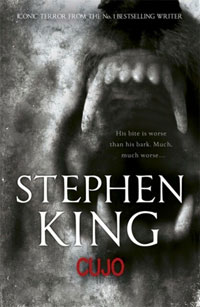(April 29 – May 10)

For the third novel in a row I am left without the comforting, informative blanket of an introduction or author’s notes. However, since King by his own admission was deep in the throes of alcoholism and remembers nothing at all about writing Cujo, it’s perhaps for the best.
Cujo is an interesting entry in the King canon. It’s an overt return to horror: the first chapter alone is a masterclass in writing about things that go bump in the night. However, it’s also a strongly allegorical story. I mean, almost every novel is going to be allegorical in some ways, even if only in reflecting the author’s own experience. However, Cujo centres itself around a big, cuddly St Bernard who is turned into a monster due to (very physiological) forces beyond his own control. Not too far removed from a big, cuddly author who can feel himself turning into a monster through substance addiction.
However, you can’t spin an entire novel around a rabid dog, so there’s a lot more going on here. Most of the narrative follows two families: the family who own the dog and the family most directly impacted by its rampage. Both families are in crisis, and Cujo somehow becomes the catalyst that forces those issues into inescapable focus. Although I didn’t especially enjoy the book (for more on that, keep reading) I’m blown away that King can write something as well-rounded, coherently themed and multi-layered as Cujo while in a state that would find most of us struggling to find our way to the toilet.
Perhaps the only real sign of King’s state of mind is the structure of the novel. As I believe I wrote previously, both Firestarter and The Dead Zone find King trying different ways of structuring a narrative. Cujo, conversely, is a steam train that starts at the beginning and doesn’t let up until it’s done. There are no chapters; the only breaks are between scenes; and there are no chunky flashbacks filling out gaps in the plot.
Cujo is King’s second novel set in the fictional Maine town of Castle Rock—and we get a much closer look at the place than we did in The Dead Zone. Perhaps most interestingly for enthusiasts of King continuity, there are various direct references to The Dead Zone (specifically in the mentions of the serial killer featured in that book, and the return appearance of Sheriff Bannerman). However, the aspect I found most interesting is the first vague shadows of what would eventually become It—the idea that evil can pervade throughout a town, and across time, and that it may choose to spend its spare time lurking in a young child’s closet.
The Adaptations
There is one adaptation of Cujo; a 1983 movie. This arrived at a time when Hollywood was crazy for Stephen King adaptations and somehow ended up being released just before the movie adaptation of The Dead Zone; as such, any references to events in that story were removed from the movie before release.
It’s an oddly faithful adaptation (having recently given it a watch so I could wrap up this post) something which does not work in its favour. There are plot threads which are an important part of the novel that get squeezed in here and yet are given short shrift, but really should have been dropped in favour of streamlining the story. The movie is hugely elevated by some tremendous acting and some gorgeous cinematography (from Jan de Bont) but sits in a strange netherworld by virtue of being neither a terrible nor or an especially memorable adaptation.
Incidentally my favourite bit of movie trivia is that the adaptation of King’s previous book, Firestarter, starred Drew Barrymore. Meanwhile, Cujo stars Dee Wallace, who played Barrymore’s mother in E.T. (Wallace also starred in one of my favourite movies, The Howling, which is also about shaggy beasts that like to bite people).
The Reading
I think, though I’m not sure, that this is my first time reading Cujo and despite my admiration for what King achieved in managing to write the novel, it has definitely been my least favourite read so far. There is a vein of nastiness (possibly derived from self-loathing?) that runs through the entire book. I’ve often admired the no-holds-barred approach that King takes to his writing—the fact that he will not shy away from the darkest places is, in my opinion, one of the things that has contributed to his reputation. However, Cujo is different: it’s a bleak, hard novel in which our protagonists suffer pretty much from start to finish. There are terrible characters who are instrumental in ruining lives, and even when those people are out of the way there are other things waiting in the shadows ready to tear people apart (sometimes literally, sometimes metaphorically).
There was a point around halfway through where I considered simply not finishing the book. I was moderately invested in the characters, but I wasn’t sure that this was a journey I really wanted to go on. Nevertheless, I did push through to the end and I’m glad I did. It’s probably not a novel I’ll be rushing to read again, but it’s still an impressive work and a fascinating glimpse of what you get when King finds himself down in some of those dark places.
